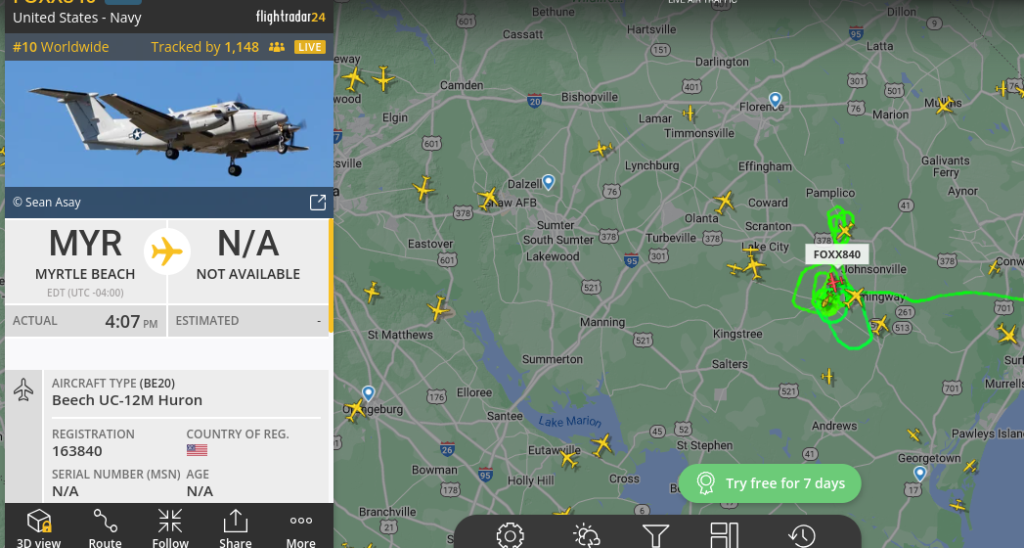I refrained from jumping in on this story, at least publicly, until now. That was mostly because of a lack of data for me to comment intelligently.
What we know for sure
We know that the missing jet was a Marine F-35 B (The ‘B’ model is the VTOL variant) from MCAS Beaufort. The single-seat fighter assigned to “The Warlords” of Marine Fighter Attack Training Squadron (VMFAT) 501 went down north of Charleston, S.C., after taking off from nearby Marine Corps Air Station Beaufort.
The pilot ejected from the aircraft at an altitude of approximately 1,000 feet and one mile north of the Charleston International Airport. The pilot then landed safely in a residential backyard. The pilot, whose name has not been released, had no major injuries and was in stable condition before being discharged from a local hospital. No civilian injuries have been reported from the incident.
After a lengthy search the debris field from the crash was located.
“The debris was discovered two hours northeast of Joint Base Charleston,” reads a statement from Joint Base Charleston, S.C., “Teams from Joint Base Charleston, Marine Corps Air Station Beaufort, the 2nd Marine Aircraft Wing out of MCAS Cherry Point, Navy Region Southeast, the FAA, the Civil Air Patrol, as well as local, county, and state law enforcement across South Carolina have been working together to locate the U.S. Marine Corps F-35B.”

What we might know
There have been several unconfirmed reports that the pilot engaged the auto-pilot before ejecting. I have to stress that those reports are, as of now, unconfirmed. If and when those reports are confirmed, I would like to know why. I can think of at least one reason, and that was because the craft was over a populated area, but that is just rank speculation.
There have also been reports that the transponder, a radio device that broadcasts the location of the jet to air traffic control, was either inoperable or off. While it is not uncommon for US military flight to have the transponder off, it is not common for a military flight to take off with an inoperable transponder.
What we don’t know
At this point, three days after the crash, we still do not know why the pilot ejected. Was there a major systems malfunction? Did the pilot go all Leeroy Jenkins? We also do not know why it took so long to find the debris field. Hopefully we’ll get answers to those questions sometime soon.
Some more stuff
The Marines have called an Aviation stand-down.
Following three Class-A aviation mishaps over the last six weeks, Acting Commandant of the Marine Corps, Gen. Eric M. Smith, directed all Marine Corps aviation units to conduct a two-day stand down in operations this week to discuss aviation safety matters and best practices.
During the stand down, aviation commanders will lead discussions with their Marines focusing on the fundamentals of safe flight operations, ground safety, maintenance and flight procedures, and maintaining combat readiness. This stand down is being taken to ensure the service is maintaining operational standardization of combat-ready aircraft with well-prepared pilots and crews.
This stand down invests time and energy in reinforcing the Marine aviation community’s established policies, practices and procedures and ensures Marine Corps remains a ready and highly-trained fighting force.
For media queries on the recent F-35B mishap, contact 2nd Marine Aircraft Wing Communication Strategy and Operations at 2ndmawcommstrat@usmc.mil.
For updates on the ongoing search and recovery operations for the F-35B, contact Joint Base Charleston Public Affairs at 843-963-5608 or https://www.jbcharleston.jb.mil/Contact-Us/.
The other two Class A mishaps were the Aug. 24 crash that killed Maj. Andrew Mettler who was piloting a F/A-18D Hornet during a training flight originating from MCAS Miramar, Calif and the MV-22 crash on Melville Island off the coast of northern Australia, that killed Maj. Tobin Lewis, Capt. Eleanor LeBeau and Cpl. Spencer Collart. Five other Marines were hospitalized.
The Military classifies ‘mishaps’ based on the dollar value of the damage and whether or not someone died. A Class A mishap is when the loss exceeds $2m and/or someone loses their life as a result of the mishap.